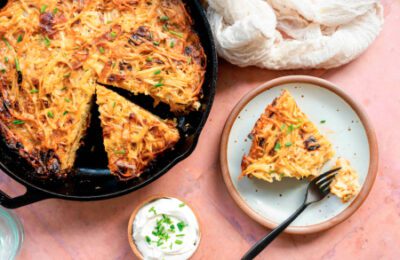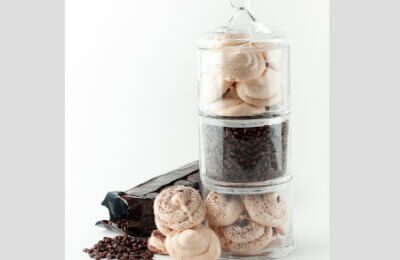
By Linda Morel, JTA
NEW YORK — I start Passover food shopping by buying six dozen eggs, but its never enough. Inevitably I return to the store at least twice, purchasing two or three more cartons of eggs each time.
Matzah garners most of the attention in Passover fare because of the unleavened breads prominent role in the Exodus story. Eggs, however, are the unsung heroes, working behind the scenes, enhancing nearly every recipe consumed during the holidays eight days.
Without fanfare, eggs perform the binding and heavy lifting usually accomplished by flour, the silky powder ground from cereal grains that are forbidden during Passover.
With great prowess, eggs hold together the ingredients that go into Passover kugels, matzah brie and matzah farfel casseroles.
When egg whites are whipped to a frenzy with electric beaters, they increase in volume six to eight times, lending structure and leavening to many baked goods.
Egg whites single-handedly add loft to cakes and other pastries, encouraging them to rise without a boost from the usual sources flour and baking soda.
Eggs play a pivotal role during seders. Spherical and white, they symbolize the rebirth that occurs in the spring. Every seder plate reserves a place to display a roasted egg to remind us of the daily roasted sacrifice in the Temple.
In addition, the roasted egg on the seder plate is a symbol of the new life the Jewish people acquired in attaining their freedom from Egyptian bondage.
During seder ceremonies all over the world, Jews consume an egg course. Ashkenazim partake in eggs that have been hard boiled and chilled. During the seder they pour heavily salted water over the eggs, a symbol of the tears shed by our ancestors during slavery.
As a child, I looked forward each spring to the taste of hard-boiled eggs in a salty bath. When I was 12, I prepared the combination for lunch one day during October. But as I took a bite of boiled egg doused in salty water, it tasted so terrible I couldn’t eat it.
I was crushed by the disappointment and concluded at that young age that you have to wait for Passover to appreciate this special dish resonating with so much history.
During Passover, many Sephardim eat an egg dish called huevos haminados in Spanish, or oven eggs.
The recipe is prepared by layering eggs among onion skins and coffee grinds in a pot of water. The mixture is then warmed in the oven on a low temperature for many hours. This slow cooking method not only gives egg yolks a satiny texture, but also turns their shells a splendid brown color, reminiscent of roasted eggs.
Many huevos haminados recipes suggest saving the skins from the onions used in Passover cooking. However, I find that method does not produce a large enough yield. In preparation for making huevos haminados, I go from supermarket to supermarket collecting skins from bins of onions.
The skins of red onions lend the most gorgeous color.
Every spring my husband worries that I will be accused of shoplifting for this practice. So far, cashiers have given me nothing more than strange looks when I point out a bag full of onion skins.
WHILE Passover is perhaps the most cherished of Jewish holidays, for many people the sheer volume of eggs used in recipes poses health issues, specifically regarding cholesterol. There are several ways to be health conscious while observing the eggs role during seders.
The yolk is the culprit, containing all the eggs cholesterol and fat (about 5 grams in a large egg). With only about 20 calories, the egg white consists of water and slightly more than half the eggs protein.
For the seder’s egg course, I recommend preparing large eggs. Ironically, large eggs are the smallest size available commercially, followed by extra large and jumbo.
Another way to cut down on cholesterol is to slice hard-boiled eggs in half, thus limiting portion size. For those who want to get fancy, place a tiny dollop of caviar on each half. Cover the halves with plastic wrap before serving, so the yolks dont dry out.
For a cholesterol-free egg course, serve egg white omelets. I suggest stirring some chopped parsley into the beaten egg whites to give them spring color.
This also adds the symbol of Passover greenery. Of course, egg white omelets can be served for breakfast, brunch or lunch throughout Passover.
When it comes to matzah casseroles made with vegetables or fruit, you can eliminate one or two of the egg yolks called for in recipes. Add an egg white for each yolk you discard.
OF course the highlight of any seder is a rich chocolate cake, made lofty and moist by a bevy of luscious eggs. If youre counting calories or cholesterol, dessert is the one place to splurge with an abundance of eggs. To balance a cake’s opulence, serve it with fresh strawberries.
During Passovers eight days, I often return to the supermarket for additional ingredients. I end up making more macaroons, either coconut or chocolate almond; matzah brei, either mushroom or classic; Passover lasagna, with or without meat; or my signature dish, peach kugel.
These recipes wouldnt exist without the most ubiquitous ingredient in all of Passover cooking eggs.
Huevos Hamindos
Prepared entirely in the oven, these oven eggs turn sepia brown and are served at Sephardic seders as the egg course.
Ingredients
- 4 cups of tightly packed onion skins
- 12 eggs at room temperature
- 2 tbsp. coffee grinds
- 1 tbsp. cooking oil
- 1 tbsp. Balsamic vinegar
- 1 tsp. salt
Instructions
-
Preheat oven to 250°. Place half of the onion skins at the bottom of a 4-quart ovenproof pot or casserole. Nestle the eggs between the skins. Dont crowd them. Sprinkle coffee grinds over eggs. Add oil, vinegar and salt. Slowly pour enough water inside to submerge the mixture, about 2 or 3 quarts.
-
If using a pot, cover it with the lid. If using a casserole without a lid, cover it tightly with aluminum foil. Place eggs in the oven for 6-8 hours.
-
Remove pot carefully. Lift out eggs using a long-handled slotted spoon and place them temporarily on paper towels to drain off excess water. Eggs can be served hot or refrigerated for later.
Vegetarian Passover Lasagna
Ingredients
- No-stick cooking spray
- 2 vegetable bouillon cubes
- 6 tbsp. olive oil, or more, if needed
- 2 large onions, sliced
- Kosher salt to taste
- Freshly ground black pepper to taste
- 9 pieces of commercially prepared matzah
- 2 zucchinis sliced into circles about 1/8-inch thick
- 6 garlic cloves, minced
- 2/3 cup Parmesan cheese, optional
- 1 lb. of mushrooms, sliced
- 3 dried sage leaves, crushed
- 2 large pinches of dried rosemary needles
- 6 eggs
- Juice from half a lemon
Instructions
-
Coat 10x15" baking pan with cooking spray and reserve. In second baking pan, dissolve bouillon cubes in 3 cups of boiling water and reserve. Preheat oven to 350ºF.
-
In a large skillet, heat 2 tablespoons of olive oil on a medium flame. Add onions and sprinkle with salt and pepper. Sauté until onion slices wilt, about 5 minutes. Move onions to prepared pan and distribute evenly.
-
Submerge 3 squares of matzah into bouillon bath until barely softened. Gently lift matzah pieces one at a time. Cover onion layer with the first 2 pieces of matzah. Break the third piece in half to fill in the edges on one side. (Don't worry if matzah falls apart slightly. But if it completely disintegrates, soften additional pieces.)
-
To the skillet, add 2 tablespoons of olive oil. Add zucchini and half the garlic, sprinkling lightly with salt and pepper. Saute until wilted, about 5 minutes. Cover matzah layer with zucchini mixture. Sprinkle 1/3 cup of Parmesan cheese on top, if using.
-
Repeat Step 3 and cover zucchini layer with 3 pieces of matzah.
-
To the skillet, add 2 tablespoons of olive oil. Add mushrooms and remaining garlic, sprinkling lightly with salt and pepper, plus sage and rosemary. Saute until mushrooms wilt, about 5 minutes. Cover second matzah layer with mushroom mixture. Sprinkle 1/3 cup Parmesan cheese on top, if using.
-
Repeat Step 3 and cover mushroom layer with 3 pieces of matzah.
-
In a large mixing bowl, beat eggs until foamy. Add lemon juice and 1 cup of bouillon and beat again. Pour egg mixture over the top of the lasagna. With a spatula, press down on the lasagna to even out liquids.
-
Bake until lasagna is firmly set and bubbles at the edges, about 45 minutes.
Recipe Notes
For a parve version, omit the Parmesan cheese. Recipe can be served immediately or made 2 days ahead, refrigerated, and reheated. Recipe freezes well.
Passover Peach Kugel
Ingredients
- No-stick vegetable spray
- 2 cups apple juice
- 2/3 cup dried cherries
- 2 15-oz. cans sliced peaches
- No-stick vegetable spray
- 3 pieces of matzah, broken into 1-inch squares
- 6 eggs
- Zest and juice from half a lemon
- 2/3 cup sugar
- 1/4 tsp. salt
- 1/2 tsp. cinnamon
- 1/8 tsp. nutmeg
- 2/3 cup chopped walnuts
- 4 tbsp. margarine or butter melted
Instructions
-
Coat a 9-by-13-inch ovenproof baking pan with no-stick spray. Preheat oven to 350°.
-
In a small pot, heat 1 cup of apple juice to a simmer. Remove from flame. Stir in dried cherries and soak them while assembling remaining ingredients.
-
Place a colander over a large bowl. Drain the peaches, reserving the liquid from the can in the bowl. Dice peaches.
-
In a medium-sized pot, heat the remaining apple juice to a simmer. Remove from flame. Soak broken matzah squares in apple juice until soft, about 5 minutes. Using the colander, drain matzah and discard the juice. Reserve.
-
With an electric beater, whip eggs until frothy. Add lemon zest and juice, sugar and salt, and beat until well combined.
-
Drain the cherries and add them to the egg mixture, along with the peaches and walnuts. On a low speed, mix until incorporated. With a wooden spoon, add soaked matzah and gently stir until incorporated.
-
Move mixture to prepared pan and spread evenly. Pour 1/3 cup of the reserved peach juice evenly over the top. Drizzle the melted margarine or butter over the surface.
-
Kugel will look quite liquid. Place kugel in the oven and bake for 45 minutes, or until edges brown and a tester inserted in the middle comes out clean. Serve immediately or cool to room temperature, cover with plastic wrap, and refrigerate for a day.
-
Cut into squares before serving. Kugel tastes delicious with sour cream.
More Passover recipes, including a full seder menu, available in the IJN’s special Passover Foods supplement. Order your copy by calling Carol at (303) 861-2234 or email [email protected].
















